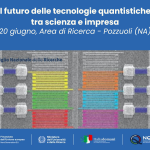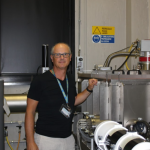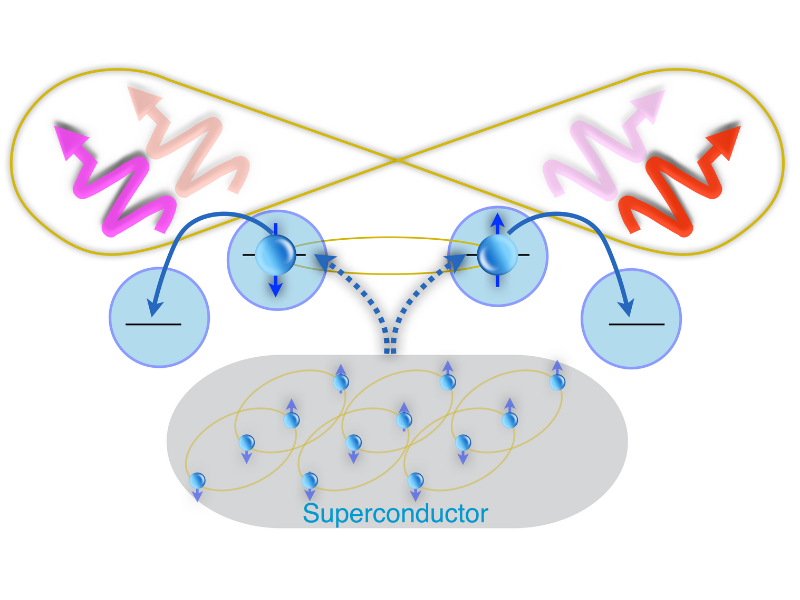
The Future of Quantum Technologies between Science and Industry: Workshop
June 19, 2025
Leonida Antonio Gizzi Appointed Scientific Director of the European Extreme Light Infrastructure (ELI)
July 7, 2025A recent theoretical study authored by an international team—including researchers from CNR-INO—introduces an innovative method to generate entangled photon pairs in the microwave regime.
Published in PRX Quantum and featured by Physics Magazine of the American Physical Society, the work opens new avenues for quantum technologies.
Quantum entanglement—a deep and non-classical correlation between particles—is a cornerstone of the emerging technological revolution in communication, computation, and metrology. Until now, controlled generation of entangled photon pairs has been largely restricted to the optical domain. This new study proposes harnessing Cooper pairs—entangled electron pairs in superconductors—to generate entangled microwave photons.
At the heart of the proposal is a nanoscale device that combines superconductors, quantum dots, and photonic circuits into a fully chip-integrable hybrid architecture. By employing Cooper pair splitters based on double quantum dots, the system spatially separates a Cooper pair into two distinct channels, inducing the simultaneous emission of two frequency-entangled photons.
To better understand the significance of this study, Physics Magazine interviewed Gianluca Rastelli, researcher at CNR-INO. Below are selected excerpts from that interview.
What motivated this study?
Entanglement is a special connection between parts of a quantum system and is essential for many quantum technologies. Transferring this correlation between different kinds of particles—such as electrons and photons—is crucial to developing quantum devices.
You propose a method to generate entangled photon pairs in the microwave domain from Cooper pairs. Is that correct?
Yes, that’s correct. Our work is based on two key concepts:
-
Superconductors contain entangled electron pairs (Cooper pairs). These can be spatially separated using “Cooper pair splitters,” preserving their entanglement. Previous studies explored this possibility by measuring electrical currents in nanoscale circuits.
-
In our study, we consider such superconducting nanodevices coupled to microwave quantum photonic systems. Unlike optical photons, microwave photons do not propagate freely and must be guided through on-chip electronic circuits. Our proposal is inspired by recent advances in nanofabrication, which enable the integration of superconducting components with microwave quantum photonic devices.
What do you consider to be the main advancement presented in your article?
Until now, it has not been possible to directly observe the entanglement of a single Cooper pair within a BCS condensate. Our scheme aims to overcome this challenge by providing a method to access this fundamental aspect of superconductivity. Compared to previous theoretical proposals—often based on complex charge or spin transport measurements—our approach transfers the entanglement from electrons to photons, for which reliable detection techniques are available. Furthermore, the proposal may offer a new tool to explore more complex quantum states, such as those found in topological or unconventional superconductors, where electronic entanglement takes on different forms.
Why are you and your team excited about your findings? And how do you envision others might use them?
Our approach integrates advanced components of nanoscale quantum systems, combining superconducting nanocontacts, semiconductor quantum dots, and microwave devices.
We have identified potential challenges and risks and demonstrated that overcoming them requires state-of-the-art nanofabrication techniques. We believe this work paves the way for future experimental investigations of this hybrid architecture.
Is there anything else you think is important to know about the work?
In addition to presenting our proposal, we provide an overview of current research in hybrid quantum nanocircuits (semiconductor–superconductor systems) and microwave quantum photonics. We discuss some of the key open challenges and the potential of these systems for future quantum applications.
This approach could enable, for the first time, the experimental verification of entanglement in a single Cooper pair—an objective that has so far remained out of reach for the scientific community.
The work presents a theoretical proposal developed through close collaboration between two theorists—Gianluca Rastelli (CNR-INO) and Michele Governale (Victoria University of Wellington, New Zealand)—and two experimentalists—Pasquale Scarlino (EPFL, Lausanne, Switzerland) and Christian Schönenberger (University of Basel, Switzerland).
The significance of this work also lies in its long-term vision: to bring quantum photonics in the microwave regime to the same level of maturity as its optical counterpart. This would enable the development of new quantum computing architectures, ultra-sensitive sensors, and secure communication networks fully integrable on a chip.
To learn more:
https://journals.aps.org/prxquantum/abstract/10.1103/PRXQuantum.6.020339
https://physics.aps.org/articles/v18/s70





